Cement industry is therefore an energy- and material-intensive industry
Cement is the primary component in concrete and therefore one of the most important modern materials. Cement works as a ‘binder’ in concrete and is crucial for its properties. In our modern society, concrete is an ever-present and indispensable building material that can be found in a wide range of structures: from residential buildings to skyscrapers, from bridges and road surfaces to mighty reservoir dams.
In 2017, around 34 million tons of cement was produced in Germany, emitting roughly 20.5 million tons of CO2 into the atmosphere. This accounts for roughly two percent of all greenhouse gas emissions and around ten percent of industrial emissions. The cement industry is therefore an energy- and material-intensive industry. Particularly relevant are the large quantities of CO2 emitted while making cement clinker, the intermediate product during cement production.
Strategies and challenges for a climate-neutral cement industry
The cement industry has spent decades working on strategies to improve its climate footprint. Continuous improvements have been made in energy efficiency, for example, involving both the use of waste heat and the effective use of electricity. Secondary by-products such as blast furnace slag or fly ash have been used to replace some of the cement clinker in cement, while waste-derived materials (such as old tyres or industrial waste) have replaced fossil fuels. Research is also being carried out for alternative binders.
However, current developments focus in particular on technologies for CO2 capture, since emissions from raw materials cannot be avoided at present. Overall, there are many technological approaches whose development has reached varying degrees of maturity. While some are already being tested on an industrial scale, others still require fundamental research.
Established solutions no longer effective – research on new technologies needed
Challenges for the cement industry lie in the fact that solutions that have already been successfully established can no longer be implemented in the medium term. This is due to specific measures targeted in other sectors as part of Germany’s 2050 Climate Action Plan, such as the phase out of coal-fired power generation. In the future, by-products such as blast furnace slag and fly ash, as well as suitable waste-derived fuels (like plastic waste), will either become unavailable or no longer available in sufficient quantities. Further research for electricity-based process heat generation will therefore also be advanced.
Setting the framework conditions for cutting CO2 emissions
In order for the cement industry to successfully implement strategies to reduce its CO2 emissions, political and economic course-setting is necessary. Many of the new technologies require large amounts of electrical energy, which is why the expansion of renewable energy must be driven forward. A clear regulatory framework will be required for issues relating to the capture, transport and use of CO2. Standards and regulations will also need to be revised. Last but not least, a market for ‘green’ cement must also be established.
